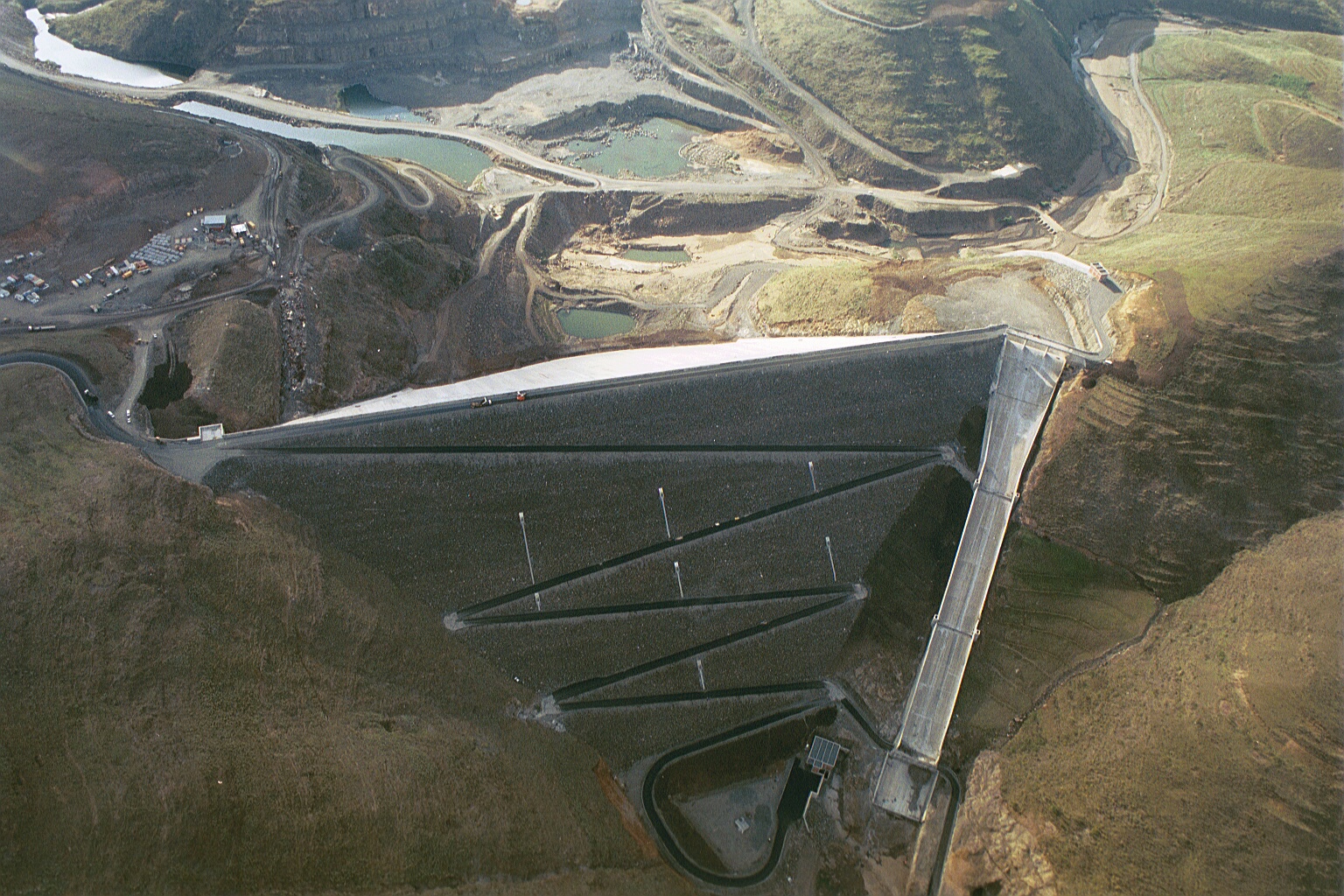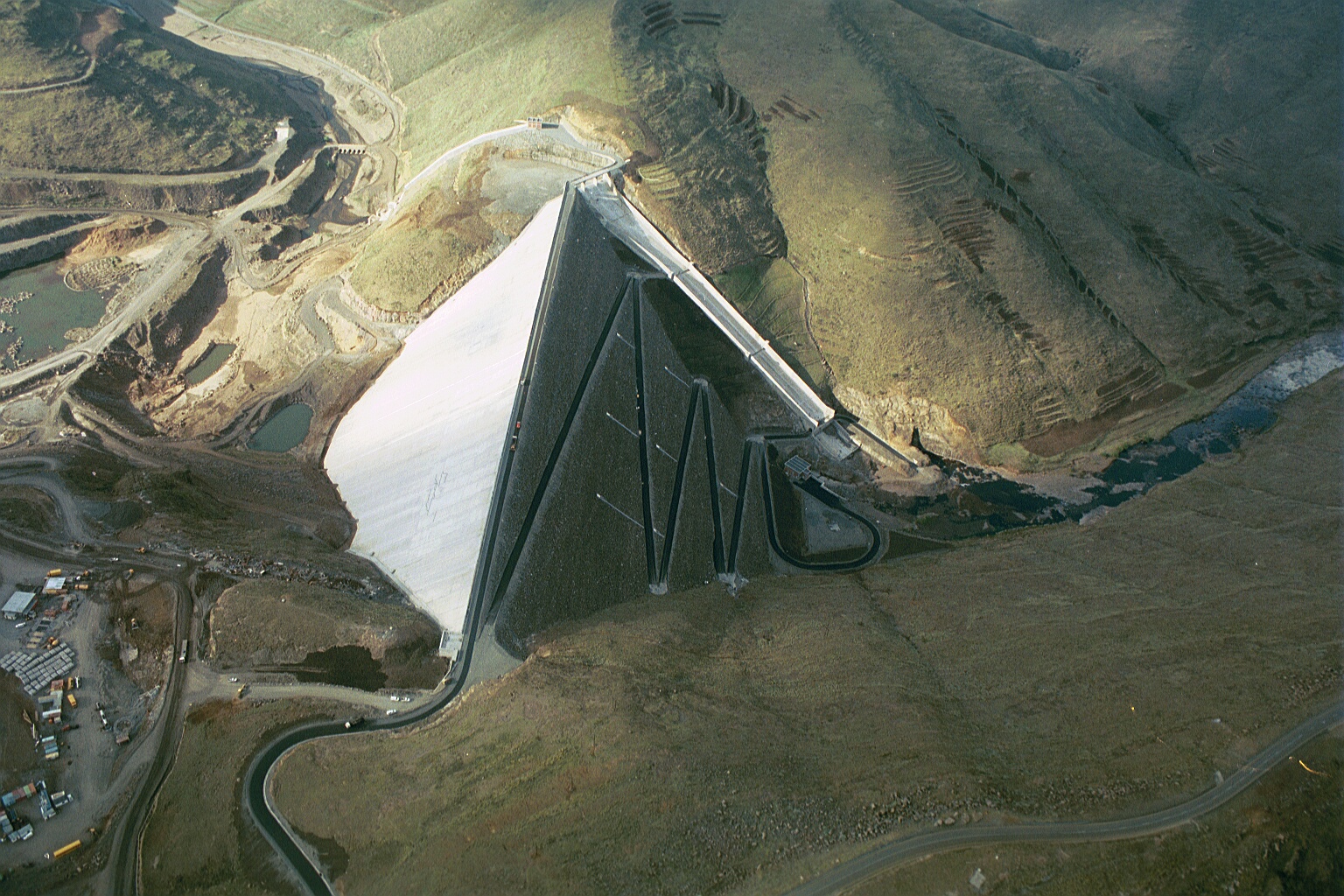Project profile
The Lesotho Highlands Water Project (LHWP) is a bi-national water infrastructure project between the governments of the Republic of South Africa and the Kingdom of Lesotho. It was established through a Treaty the parties signed in October 1986, outlining the terms cooperation and separate and collective obligations of the two parties. The Treaty further articulates agreements over governance structures, project design, construction, operation, maintenance and water transfer.
Lesotho Highlands Water Commission (LHWC), which comprises three delegates from each country, monitors the project and oversees the work of the implementing agents. TCTA and Lesotho Highlands Development Authority (LHDA) are respectively responsible for components of the project that fall in South Africa and Lesotho. LHDA’s mandate comprises building dams, tunnels, power stations and the related infrastructure within the borders of Lesotho. TCTA is charged with tunnelling, delivery, integration and flow control of water into the Ash River outfall in South Africa.

Overall, LHWP entails harnessing the waters of the Senqu/Orange River in the Lesotho highlands through the construction of an intricate network of tunnels and dams to divert water from the mountains of Lesotho to South Africa. Both countries will derive benefits from the development. South Africa gains include increased water suppliers for its water-stressed economic heartland of Gauteng. The mountain kingdom benefits from the revenue it receives from water sales and the building of hydroelectricity capacity. The rollout of the project is in phases.
Phase 1
LHWP Phase 1 (“LHWP-1”) was divided into 1A and 1B and concluded in 2003. The primary infrastructure constructed included the building of three dams (i.e., the Katse, Mohale and Muela), an intake tower, transfer tunnel, a delivery tunnel and a hydropower station.
In Phase 1A, the construction of the Katse Dam, a double curvature concrete arch (185 m high and 710m along the crest) in the central Maluti Mountains, and the 72MW Muela hydropower station. The dam boasts a storage capacity of 1,950 million m³ and a spillway discharge of 6,252m³/s. Besides, a 45km transfer tunnel and a 37km delivery tunnel were built.
Phase 1B implementation work included the construction of the 145m concrete-faced rock-fill Mohale Dam on the Senqunyane River. Its storage capacity is 958 million m³ and spillway discharge is at 2,600m³/s. In addition, a 32km interconnecting transfer tunnel between the Katse and Mohale reservoirs was also built. Phase 1B included construction of the 19m-high Matsoku Weir and a 6.4km transfer tunnel. Mohale Dam was completed in 2004.
Phase II
LHWP Phase 2 (“LHWP-2”) was launched on 13 November 2020 and is underway. Because of the work already completed in the previous phase, South Africa receives about 780 million m3 of water from Lesotho into its Integrated Vaal River System (IVRS) per annum. The system supplies water to the Gauteng and its surrounding areas. However, water requirements continue to increase, requiring urgent augmentation of the IVRS. LHWP-2 entails the construction of the Polihali Dam, a transfer tunnel, advance infrastructure and environmental and social development programmes in Lesotho.
The 165m high Polihali Dam will provide an additional 465 million m³ of water per year into the IVRS from Lesotho, bringing the total to about 1 245 million m³. In terms of design, it will be a concrete faced rockfill dam with a water storage capacity of 2 200 million m3. The planned 38km-long water transfer tunnel will connect the Polihali Dam with the existing Katse Reservoir.LHWP-2 will further include the construction of a pump storage scheme, the associated transmission lines and appurtenant works. The scheme will generate 1 200 MW of power.
Funding
LHWP-2 has an estimated capital expenditure cost of R32.6 billion and, as with the previous phase, is funded off-budget, meaning funds are borrowed from financial markets. In May 2021, TCTA concluded funding agreements to the tune of R15,4 billion with commercial banks ABSA, Investec, Nedbank, RMB and Standard Bank, and infrastructure financier Development Bank of Southern Africa.
The organisation will use the funding to refinance existing debt and to fund capital expenditure on LHWP-2. Of the total funding of R15,4 billion, TCTA has earmarked R3.6 billion for the refinancing of the R9,4 billion WSP-5 bond, which matured on 28 May 2021. The balance will contribute to LHWP-2 capital expenditure. The total project cost for LHWP-1 was R16,4 billion.
TCTA relies on the revenue it generates from the IVRS water sales to service the loans it raises towards LHWP, a sustainable, bankable, bulk raw water infrastructure project with an explicit government guarantee. The South African Government is responsible for the full water transfer costs both TCTA and the LHDA incur. These costs are included in TCTA’s statement of financial position.
Socio-economic development
As per the terms of the Treaty between South Africa and Lesotho, TCTA and LHDA manage social development in the project-affected areas following global best practice and World Bank guidelines. As the implementing authorities for LHWP, they are responsible for the social, environmental and economic development programmes in their jurisdictions. These include resettlement, compensation, the supply of water to resettled villages, irrigation, fish hatcheries and tourism.
Environment
The agreement between South Africa and Lesotho stipulates environmental protection and sustainability of the river system. In Lesotho, the LHDA implements the programme, while in South Africa, TCTA is responsible. The LHWC monitors both bodies. So far, no significant incidents have marred the project’s overall environmental performance. The Lesotho Highlands Development Authority reviews the relevant policies on an ongoing basis and makes changes to operational procedures, where necessary, to achieve the requisite results. An international Panel of Environmental Experts reviews the performance of the LHDA twice a year and, overall, is satisfied with the results.
Operation and maintenance
In terms of the Treaty, as amended by Protocol IV between the Republic of South Africa and the Kingdom of Lesotho, TCTA is responsible for the operation and maintenance of the portion of Delivery Tunnel North of the project situated in the Republic of South Africa. It is accountable to the LHWC in this regard and has operations and maintenance obligations to ensure that the infrastructure delivers the required volumes of water (641 million m3 per year ). The operation and maintenance of the scheme are being done following the annual maintenance plan.
Future phases
The parties to the Treaty have already conceptualised Phase 3 and 4 of LHWP. The implementation works under these phases will principally comprise the building of new dams and the associated infrastructure. Once completed, LHWP will consist of five dams and about 200km of tunnels and water transfer works constructed between the two countries. It will transfer about 2 000 million m³ of water from Lesotho to South Africa every year.

















